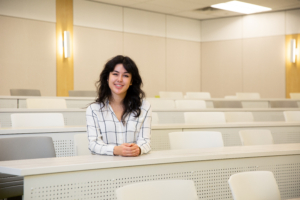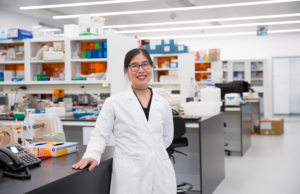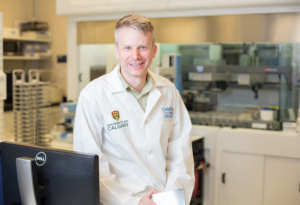Bachelor of Health Sciences student at the Cumming School of Medicine turns cancer diagnosis into opportunity to help advance research

Cumming School of Medicine student and cancer survivor, Milan Heck.
When Milan Heck first noticed a lump on her hip, she and her family blamed it on the boot cast she wore to heal her broken ankle. But on Aug. 31, 2015, they learned that an abnormal gait wasn’t the culprit. Heck had a tumour. Two-and-a-half weeks later, she found herself at the Alberta Children’s Hospital waiting to meet her oncology team.
“That meeting is when everything became real,” says Heck, who’s now a second-year Bachelor of Health Sciences student at the Cumming School of Medicine (CSM). “That’s the first time I recall thinking, ‘That’s it. This is cancer.’ I felt numb. I put on a stoic face, surrounded myself with people and tried to make the situation as lighthearted as possible. I think that’s what has helped me cope throughout the years.”
Heck was diagnosed with alveolar soft part sarcoma (ASPS), a malignant soft tissue tumour which starts in the soft connective tissues of the body such as fat, muscles or nerves. ASPS usually starts in the legs or arms and most often metastasizes to the lungs but can involve other organs, such as the brain or bones.
“What felt like a small lump turned out to be a tumour the size of a grapefruit,” says Heck. “Upon initial diagnosis, my doctors also found a lesion on my brain and 13 lesions across my lungs. I was completely in shock.”
Over the past six years, Heck has undergone nine surgeries, two radiation treatments and has tried numerous medications. Many of which caused unpleasant side effects and complications. While experts do their best to recommend therapies, they face many challenges when diagnosing and treating them.
But thanks to the participation of cancer patients and innovative research methods, new treatment options are on the horizon.
Developing a better understanding
Dr. Jennifer Chan, MD, a pathologist and the scientific director of the CSM’s Arnie Charbonneau Cancer Institute, explains that there’s no standard treatment for most rare cancers because there’s less research on them and, in turn, not enough information to support drug development.

Dr. Jennifer Chan
“The good news is that researchers are no longer studying ‘cancer,’ we’re investigating the various types and subtypes of cancer, and we’re doing it in creative and innovative ways,” says Chan who’s also an associate professor in the Department of Pathology & Laboratory Medicine. “The better we understand a cancer, the better we can treat it.”
One of these ways is by banking leftover clinical samples for research. Another is by using the collected tissue samples to make tumour models from the patients’ cancers. The models allow researchers to study the development and progression of a tumour, and test new treatments to see which ones are effective.
Thousands of Calgarian patients are making this research possible by contributing pieces of tumour tissue extracted during surgical or biopsy procedures. Heck is one of them, and her samples are currently being used by a team of UCalgary researchers to better understand ASPS.
Giving a gift for research
“When one of my surgeons talked to me about participating, it was an easy decision for me,” says Heck. “Knowing that my donation could help generate knowledge about ASPS, I immediately said ‘yes.’”
To date, Heck has donated three samples, which have been stored within the Charbonneau Institute’s Clark H. Smith Tumour Centre’s tissue bank — a biorepository that specializes in neurological and pediatric diseases and provides samples to local, national and international researchers. The biobank is directed by Dr. Chan who explains that collected samples can sometimes be stored for a while before they’re used. Earlier this year, Heck’s samples were pulled and a team of researchers is now focused on finding new treatments.
“Choosing to participate is like giving a gift for research,” says Chan. “Understanding tumour biology is a critically important step in the process of finding new therapeutic approaches, reducing toxicity of current therapies and improving patient experience. Without participant samples, we wouldn’t be able to model or study these tumours in the same way we are now.”
A more tailored approach
Dr. Douglas Mahoney, PhD, a member of the research team and an associate professor in the departments of Microbiology, Immunology & Infectious Diseases and Biochemistry & Molecular Biology, explains that the live samples from the biobank are what allow researchers to test treatments and develop more personalized treatment plans.

Dr. Douglas Mahoney
“The more we learn from these studies, the more tailored our treatments will become,” says Mahoney. “Up until now, this rare disease didn’t have many preclinical models and we’ve generated them. Now we’re starting to use cell-based therapies to see if they’ll work in vivo.”
Mahoney and his team are using Chimeric Antigen Receptor or CAR T-cell immunotherapy, which uses synthetic biology to modify T-cells — a type of white blood cell that’s essential to the immune system —to recognize and kill the cancer cells. This therapy has successfully treated children and adult patients with forms of leukemia and lymphoma and there’s growing evidence that engineered immune cells also have the potential to be broadly applicable across more types of cancer.
The team has built a new CAR T-cell therapy specifically for ASPS and is testing it against Heck’s cancer. One day, it could become a treatment for ASPS patients like her.
“My hope is for safer, better therapies for cancer patients,” says Mahoney. “There’s no guarantee that we ever achieve that, but we have the tools, ideas and right people to take a fantastic shot at it.” Heck agrees.
“New ways of treating cancer are on the horizon,” she says. “Even if I don’t see that happen in my lifetime or receive any of the treatment, I know that there’s potential for someone else down the line to benefit from the knowledge that’s being created, and that’s a silver lining.”
In 2023, the new Calgary Cancer Centre (CCC) will open and will be the largest comprehensive cancer care centre in Canada. The space will create a fully-integrated environment that enables experts like Drs. Chan and Mahoney to efficiently advance their research from discovery, invention, preclinical studies and clinical trials; improving the experience and prognosis of cancer patients. Learn how you can help make a difference by contributing to the CCC or tissue bank.
Dr. Jennifer Chan, MD, is the scientific director of the Arnie Charbonneau Cancer Institute and an associate professor in the Department of Pathology & Laboratory Medicine at the Cumming School of Medicine. She is also a member of the Alberta Children’s Hospital Research Institute at the University of Calgary.
Dr. Douglas Mahoney, PhD, is an assistant professor in the departments of Microbiology, Immunology and Infectious Diseases and Biochemistry & Molecular Biology at the Cumming School of Medicine. He is also a member of the Alberta Children’s Hospital Research Institute, Arnie Charbonneau Cancer Institute, and Snyder Institute for Chronic Diseases at the University of Calgary.
Written by Melanie Tibbetts for the Cumming School of Medicine.



